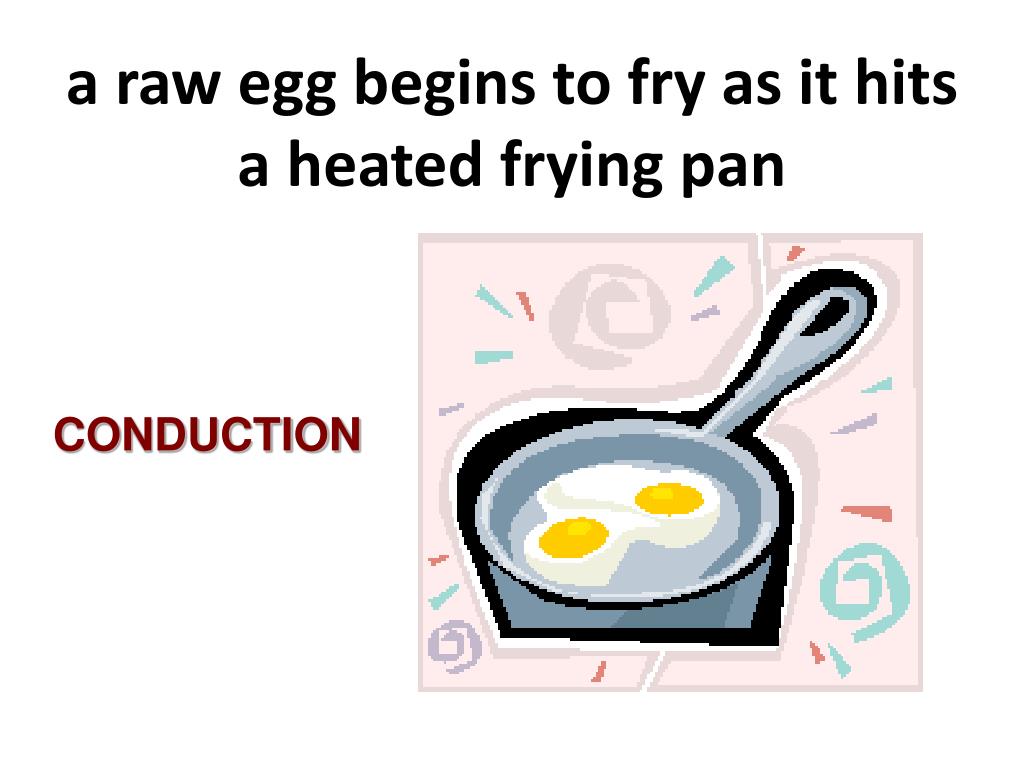Conduction is the process of heat being transferred between objects through direct contact, and it’s the most common type of heat transfer. For example, in cooking the burners on stoves will conduct heat energy to the bottom of a pan sitting on top of it. From there, the pan conducts heat to its contents.

How to Heat Stainless Steel
Old reliable. These pans are the preferred go-to for both chefs and professionals. Stainless steel cookware is efficient, long lasting – if cared for properly – and a beautiful addition to any kitchen. Pans made from stainless steel are durable and are known for their even heat transfer, making cooking in them a dream.
Stainless is wonderful for cooking all sorts of dishes. Apart from eggs, which are better suited for non-stick cookware, stainless steel can handle almost anything you throw at it. As an added benefit, many of these pans are oven safe.
Caution: Scrubbing with an abrasive metal scouring pad can damage the surface of the pan, causing major issues with stuck food down the road. Instead, clean with a soft sponge and polish with vinegar till shiny.
Our recommended heating practice:
- Set the stove on medium to medium-high heat
- Add oil early on, and allow it to heat up with the pan
- Watch for the oil to shimmer or very lightly smoke – this is a great indicator that you have preheated to perfection
- If you don’t add oil in the beginning it is much more difficult to read the actual temperature of the pan and you will have to rely on adding water droplets from time to time to test the temperature
- In our opinion, adding oil at the beginning is a much easier and safer practice for home and recreational cooks. Water mixed with oil can splatter and burn
Additional considerations:
- Because of their heavy-duty quality and material, stainless steel pans hold heat quite well and come to temperature quickly
- Depending on your stovetop the pan may even heat up before you expect it to
- Be sure to use a high smoke point oil (like Avocado Oil), because stainless gets very hot and cooking at high temps can cause butter to burn and oil to go rancid.
- We have found no scientific evidence that proves heating your steel pan first makes any noticeable difference. The myth that heated pans expand and seal micro-fissures or better absorb oil is just that – a tall kitchen tale
Pro Tip: seasoning your stainless steel pan can help prevent rusting and SFS (stuck food syndrome). Wash and dry the pan, then coat the inside with vegetable oil and heat up in the oven. But only if the entire thing is stainless. You will not be able to do this with rubber handled pans!
How to Heat Non-Stick Pans
Who doesn’t love a good non-stick pan? Cooking is a breeze when you’ve got a slick and sleek new surface to cook on. This is an especially popular pan for home cooks worldwide.
Non-stick pans are designed for moderate heat. They are not made for high heat use. Which is why preheating them for more than 30 seconds, or at high settings is not recommended. It is also thought to be hazardous when heating empty nonstick pans. The pans get too hot too fast, which can damage the non-stick surface, potentially release toxins and can even cause your pan to warp.
These types of pans are coated with a chemical compound popularly known as Teflon. Creating a surface which is resistant to sticking, it can provide you with the option of using little to no fats — a desirable benefit for those wishing to limit their exposure to fats or people with certain dietary restrictions.
Our recommended heating practice:
- Set the stove on low to medium heat for 30 seconds at the most, just until you can feel it start to get warm but not super-hot.
- If you wish to use oil or butter, carefully add it at the beginning and allow the oil to heat up with the pan.
- There is no need to preheat non-stick pans for boiling or simmering liquids.
How To Keep Food From Sticking To Pan
FAQ
How does meat get heated in a frying pan?
How does heat travel through the pan?
What type of heat transfer is a frying pan?
How is heat transferred when frying?
How does a frying pan heat up?
It heats through convection, warming up as the heat passes through the frying pan and cooking as the meat starts to reach the proper internal and external temperature to change its state. Meat has a much lower temperature tolerance then your frying pan does.
How does a frying pan work?
When a frying pan is placed directly onto an electric burner, heat is transferred from the hot coil to the surface of the pan. A closer look—and by close, we mean close enough to see the atoms of metal that make up the pan—will reveal that as more heat is transferred to the bottom of the pan, the molecules within the pan begin to vibrate.
Why does a frying pan stick if heated?
Heat alone will not smooth the surface enough to prevent sticking. It is the combination of a preheated skillet to which you add oil that will quickly begin to cook the food so it does not stick to the pan. This version has been updated. Most of us understand the need to pay attention during cooking.
What is a high heat frying pan?
In the high heat of gas stoves, frying pans rise to a temperature between 400°F-600°F. If it is higher than this value, serious burns occur in the pan and the food. This temperature is more suitable for searing the meat in cast-iron pans. Do High Heat Ruin Pans?
